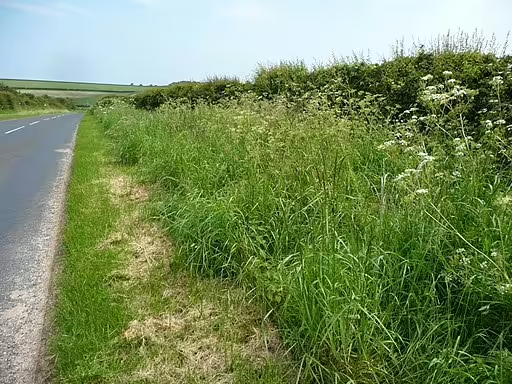Table of Contents for Downy Goldenrod (Solidago puberula)
Downy Goldenrod (Solidago puberula) is a herbaceous perennial that is native to the mid-western and eastern United States. This species is a host to the baltimore checkerspot (Euphydryas phaeton) and several moths. Growing from 1 foot to 4 feet tall, this species grows in areas such as dry open woods, dry open ground, wood edges, swamp borders, and roadsides. The yellow flowers bloom from July to October and the plant is hardy in zones 3-9.
Taxonomy and Naming of Downy Goldenrod (Solidago puberula)

Taxonomy
Downy Goldenrod (Solidago puberula) was originally named and described by Thomas Nuttall, an American botanist, in 1818. It has kept this same name since and is a member of the Aster Family (Asteraceae).
Varieties
- Solidago puberula var. puberula: native to the eastern United States and Canada, mid-cauline leaves are 4 cm to 5 cm in length
- Solidago puberula var. pulverulenta: native to the southeastern United States, mid-cauline leaves are 1 cm to 4 cm in length
Meaning of the Scientific and Common Names
Scientific Name
The genus name, Solidago, derives from the Latin words, Solidus and ago, which together mean to make (ago) whole (Solidus). This meaning comes from the medicinal uses of the plant. The species name, puberula, is Latin for pubescent.
Common Name and Alternative Names
The common name comes from the pubescent stem and leaves.
Physical Description

- Plant Type: This plant is a herbaceous perennial.
- Height: 1 ft (0.3 m) to 4 ft (1.2 m)
- Stem: The stems are erect, multi-stemmed, and pubescent (Flora of North America).
- Leaves: The leaves are alternate, with basal and cauline leaves, oblanceolate to obovate, sessile, and serrate margins. They are 2 in (5 cm) to 6 in (15 cm) long and 0.4 in (1 cm) to 2 in (5 cm) wide.
- Flower color: yellow
- Blooming period: This plant blooms from July to November.
- Fruiting type and period: This plant has achenes that mature in the late fall and winter.
Range of Downy Goldenrod in the United States and Canada


This goldenrod species has two varieties, one of which, Solidago puberula var. puberula is native to the eastern United States and Canada and another, Solidago puberula var. pulverulenta that is native to the southeastern United States. This species is considered to be rare in the states of Kentucky, North Carolina, Ohio, and the province of Ontario.
Habitat

This species grows sand barrens (Carbyn and Catling 1995), dry open woods (Lelong 1977), dry open grounds, wood edges and roadsides (Weatherby and Adams 1945), borders of swamps (var. pulverulenta) (Fernald 1935).
Hosted Insects

This goldenrod, like a lot of other goldenrods, is a host to wavy-lined emerald (Synchlora aerata). The genus in general is a host to the Baltimore Checkerspot (Euphydryas phaeton) and black swallowtail (Papilio polyxenes). This species specifically hosts a moth (Coleophora puberuloides) (McDunnough 1956).
Other Supported Wildlife

This species is a nectar source to other butterflies, skippers, bees, and wasps during the growing season. It is especially important since it provides a nectar source in the late season.
Frequently Asked Questions
Does this plant have any ethnobotanical uses?
The Native American Ethobotanical Database does not specifically cite this species, but Solidago in general has been used for pain relief, coughs, stomach ailments, and heart medicine.
How is this plant distinguished from other Goldenrods?
This goldenrod species is most similar to the Roan Mountain goldenrod (Solidago roanensis), but the Roan Mountain goldenrod has a glabrous stem, whereas this species has a pubsecent stem (Weakley 2022).
Is this plant invasive?
This has not been noted as being weedy.
Gardening with Downy Goldenrod

Hardiness
This species is hardy in zones 3-9. If your garden is within these zones and you have the right growing conditions (soil, moisture and exposure), you may well be able to grow this plant. However, if planted outside of its range, the hosted species may not recognize the plant or be harmed by ingesting a different species with an unfamiliar chemical composition.
Optimal Conditions
This species enjoys full sun to part-shade in medium to dry well-drained soils.
References
- Carbyn, Susan and Paul M. Catling. 1995. Vascular flora of sand barrens in the middle Ottawa Valley. Canadian Field-Naturalist 109: 242-250.
- Fernald, Merritt Lyndon. 1935. Midsummer vascular plants of Southeastern Virginia. Contributions from the Gray Herbarium 109: 378-454.
- Lelong, Michel G. 1977. Annotated List of Vascular Plants in Mobile Alabama. Sida 7: 118-146.
- McDunnough, James H. 1956. On the aster-and solidago-feeding species of the genus Coleophora in Nova Scotia (Lepidoptera, Coleophoridae). (New York, NY: American Museum of Natural History).
- Weakley, A.S. and the Southeastern Flora Team. 2022. Flora of the southeastern United States. University of North Carolina Herbarium, North Carolina Botanical Garden.
- Weatherby, Charles Alfred and John Adams. 1945. A list of the vascular plants of Grand Manan, Charlotte County, New Brunswick. Contributions from the Gray Herbarium 158: 1-85.


